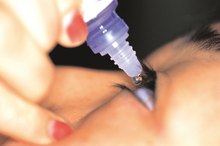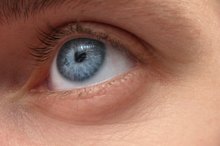Natural Alternatives to Steroid Eyedrops
Steroid eye drops are prescribed to treat eye infections, reduce inflammation and relieve dry eye. But their use is not without potentially harmful side effects. Steroid eye drops can sting your eyes or cause vision changes or reduce your eyes' ability to fight infection. In addition, allergic reactions may include rash, itching or swelling in or near the eyes. Furthermore, long-term use can lead to glaucoma or cataracts, according to the Foundation of the American Academy of Ophthalmology. Natural alternatives to steroid eye drops are available for some eye conditions and may be worth discussing with your eye care provider.
If you are experiencing serious medical symptoms, seek emergency treatment immediately.
Eye Compress
An alternative to steroid eye drops for pink eye, also referred to as conjunctivitis, is to use an eye compress 2. Make a compress by soaking a lint-free cloth in water and squeezing out the excess water. Then apply the compress to the eyes. For allergic conjunctivitis, a cool compress may be more soothing. A warm compress works best with bacterial or viral conjunctivitis, according to the health education website of the Mayo Clinic 12.
If you have pink eye only in one eye, do not use the compress for both eyes as this may spread the infection.
Over-The-Counter Eye Drops
How to Get Rid of Styes in Your Eyelids
Learn More
Over-the-counter eye drops, sometimes called artificial tears, can help soothe dry eyes and relieve pink eye symptoms. OTC eye drops that contain antihistamines or other non-prescription medications may be helpful for allergic pink eye.
Preservative-free eye drops are available for relief of dry eye symptoms. These are packaged in individual-dose vials that are discarded after use. These are useful if you need to use eye drops frequently during the day. Eye drops that contain preservatives have a longer shelf life, but may cause irritation in some people, especially if they are used multiple times throughout the day.
- Over-the-counter eye drops, sometimes called artificial tears, can help soothe dry eyes and relieve pink eye symptoms.
- OTC eye drops that contain antihistamines or other non-prescription medications may be helpful for allergic pink eye.
Ointments
Ointments can be used to treat dry eyes, according to the Mayo Clinic 1. Ointments remain in the eye giving you longer relief from dry eye. Ointments can cause blurry vision or cloud your eyes and are best suited for nighttime use before bedtime.
- Ointments can be used to treat dry eyes, according to the Mayo Clinic 1.
- Ointments can cause blurry vision or cloud your eyes and are best suited for nighttime use before bedtime.
Washing the Eyes
The Best Eye Drops for Dry Eyes
Learn More
If you have blephartitis or inflammation of the eyelids, washing your eyes can help relieve your symptoms. Use a mild soap, such as a baby shampoo or other doctor recommended soap. Use a small amount of soap on clean hands and gently wash the eyelids with your eyes closed. Rinse and pat dry.
Applying a warm washcloth on your eyes for five minutes and then wiping away the loosened debris or crust can help with pink eye and blephartitits.
- If you have blephartitis or inflammation of the eyelids, washing your eyes can help relieve your symptoms.
Precaution
Before using any alternative to prescription eye drops, consult with your doctor or health care professional for recommendations and safety precautions.
Related Articles
References
- Mayo Clinic: Dry Eyes
- Mayo Clinic: Pink Eye (Conjunctivitis)
- Azari A, Barney N. Conjunctivitis. JAMA. 2013;310(16):1721. doi:10.1001/jama.2013.280318
- Centers for Disease Control and Prevention. Conjunctivitis (pink eye). January 4, 2019.
- American Optometric Association. Conjunctivitis (pink eye).
- Matejcek A, Goldman RD. Treatment and prevention of ophthalmia neonatorum. Can Fam Physician. 2013;59(11):1187–1190.
- La Rosa M, Lionetti E, Reibaldi M et al. Allergic conjunctivitis: A comprehensive review of the literature. Ital J Pediatr. 2013;39(1):18. doi:10.1186/1824-7288-39-18
- Bischoff G. Gigantopapilläre Konjunktivitis (Giant papillary conjunctivitis). Klinische Monatsblätter für Augenheilkunde. 2014;231(05):518-521. doi:10.1055/s-0034-1368334
- The Nemours Foundation. Pinkeye (conjunctivitis). KidsHealth. June 2017
- Bielory L, Delgado L, Katelaris C, Leonardi A, Rosario N, Vichyanoud P. ICON: Diagnosis and management of allergic conjunctivitis. Annals of Allergy, Asthma & Immunology. 2020;124(2):118-134. doi:10.1016/j.anai.2019.11.014
- Cronau H, Kankanala R, Mauger T. Diagnosis and management of red eye in primary care. American Family Physician Journal. 2010; 81(2):137-144.
- Cleveland Clinic. Pink eye (conjunctivitis). April 10, 2020.
- Hutnik C, Mohammad-Shahi MH. Bacterial conjunctivitis. Clin Ophthalmol. 2010;4:1451–1457. doi:10.2147/OPTH.S10162
- Skevaki CL, Galani IE, Pararas MV, Giannopoulou KP, Tsakris A. Treatment of viral conjunctivitis with antiviral drugs. Drugs. 2011;71(3):331-347. doi:10.2165/11585330-000000000-00000
- Hemmati H, Colby K. Treating acute chemical injuries of the cornea. American Academy of Ophthalmology.
- American Academy of Ophthalmology. Pink eye (conjunctivitis).
- Goodman D, Rogers J, Livingston, E. Conjunctivitis. JAMA. 2013; 309(20):2176. doi:10.1001/jama.2013.4432
- Jefferis J, Perera R, Everitt H, et al. Acute infective conjunctivitis in primary care: Who needs antibiotics? An individual patient data meta-analysis.Brite J Gen Prac. 2011;61(590), e542-e548. doi:10.3399/bjgp11X593811
- Keen M, Thompson M. Treatment of acute conjunctivitis in the United States and evidence of antibiotic overuse: Isolated issue or a systematic problem? Ophthalmology. 2017;124(8):1096-1098. doi:10.1016/j.ophtha.2017.05.029
Writer Bio
Caroline Thompson is a professional photojournalist who has been working for print and online publications since 1999. Her work has appeared in the "Sacramento Bee," "People Magazine," "Newsweek" and other publications. She holds a Bachelor of Arts in photojournalism from California State University at Hayward and a personal trainer certification from the university's Health and Fitness Institute.









